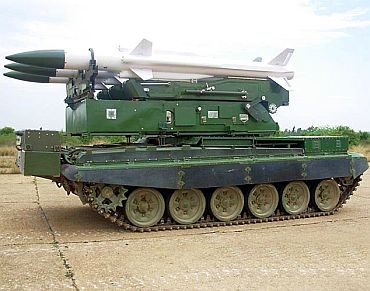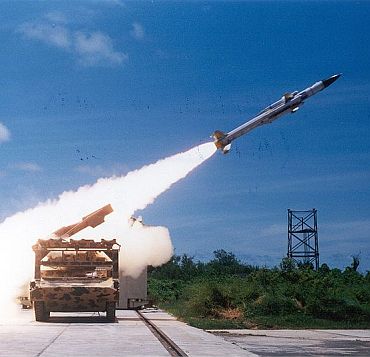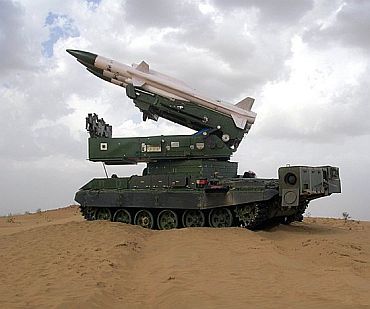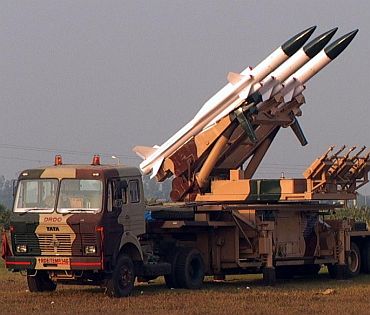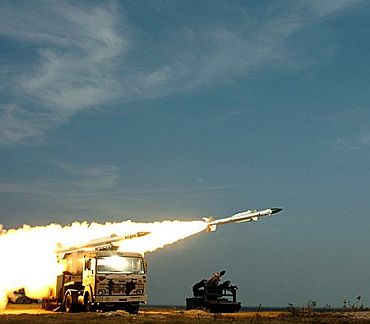 | « Back to article | Print this article |
The wait for India's first air defence system is over
With crucial Indian defence and nuclear establishments and vital infrastructure facilities open to an enemy air strike, many in India's military consider the shortage of anti-aircraft guns, missiles and radars as our single greatest security vulnerability.
For two decades, the Ministry of Defence has blocked overseas purchases, to allow the Defence Research & Development Organisation to indigenously develop anti-aircraft missile systems for replacing the obsolete Russian weaponry currently dotted around key headquarters, air bases, atomic power plants, nuclear installations and facilities like the Bhakra Nangal dam.
It has been a dangerous gamble. If war had broken out, the ineffectiveness of these Russian systems, especially the 50-year-old Pechora missile, would have forced the Indian Air Force to use its combat aircraft more for defending Indian ground forces against enemy fighters than for attacking targets in enemy territory.
But that gamble is finally beginning to pay off, with India's first modern air defence system readying to roll off the assembly line.
Click on NEXT to read further...
1st Akash squadron will protect the Gwalior air base
On an exclusive visit to Bharat Electronics in Bangalore, Business Standard was given the first-ever media look at an operational Akash missile system, which will be delivered to the IAF by March 2011.
This first Akash squadron will protect the Gwalior air base, where the IAF bases its Mirage-2000 fighters.
BEL will follow this up quickly with a second Akash squadron by December 2011, which will safeguard Lohegaon Air Base at Pune, a major base for the front-line Sukhoi-30MKI fighters.
Meanwhile, another defence public sector undertaking, Bharat Dynamics, will build six more Akash squadrons, most of these for the IAF's new fighter bases along the Sino-Indian border, including Tezpur, Bagdogra and Hasimara.
Army to order high-mobility version of Akash
"BEL is building two Akash squadrons for Rs 1,221 crore," says Ashwini Datta, BEL chairman and managing director.
"The ground infrastructure would cost another Rs 200 crore, so each squadron effectively costs about Rs 700 crore. That is not just significantly cheaper than foreign procurement, but also permits better maintenance and allows for continuous technological improvements."
DRDO and MoD sources say the Indian Army is close to ordering a high-mobility version of Akash, mounted on T-72 tanks, which can move alongside tank forces.
One of the army's three strike corps, which attack deep into enemy territory, has no anti-aircraft "area defence system"; the other two strike corps are equipped with the vintage Russian SA-6, designed in the early-1960s. This makes them dangerously vulnerable to enemy fighters if they advance deep into enemy territory.
Heart of the Akash is a mobile Rohini radar
The Akash -- developed by the DRDO, in partnership with BEL, under the Integrated Guided Missile Development Programme -- is a sophisticated amalgam of systems working in concert.
The heart of the Akash is a mobile Rohini radar, which can detect an aircraft when it is 120 kilometres (km) away; automatically, a coded electronic interrogator ascertains whether this is an IAF aircraft, or a civilian airliner.
With the target identified, the Rohini radar alerts the Akash squadron headquarters, which then controls the engagement.
As the enemy fighter races in at about 15 km per minute, the task of shooting it down is allocated through a secure digital link to one of the squadron's two missile "flights", which are normally about 25 km away, to cover the maximum area.
How Akash locks on to its target
The designated Flight Control Centre locks its sophisticated 3D phased-array radar onto the enemy fighter and calculates the launch parameters for an Akash missile to shoot down the target at its maximum range of 25 km.
Meanwhile, the flight's four Akash launchers raise their missiles to the launch positions and swivel automatically towards the incoming aircraft.
At the calculated time of launch, the Flight Control Centre electronically passes a launch order to one of its four launchers. An audio signal starts beeping and the missile operator presses the launch button, which is quaintly labelled "MARO".
A "ripple" of two missiles roars off the launcher, seconds apart, to increase the chances of a hit. The 3D radar guides the missiles throughout their flight, homing them onto the enemy aircraft.
Hits the target 98 per cent of the time
The DRDO claims that a two-missile "ripple" will destroy an enemy fighter 98 per cent of the time.
The dangerous shortage of India's air defence resources has been known to Business Standard for some time, but can only now be publicly revealed, with the induction of the Akash remedying the situation.
The number of installations that need protection -- each is termed a Vulnerable Area (VA) or a Vulnerable Point (VP), depending upon how large it is -- has steadily increased.
In a letter written on December 4, 2002, to the MoD, the IAF's Air Marshal Raghu Rajan pointed out that a study by the military's apex Chiefs of Staff Committee, ordered by the Cabinet Secretariat, had identified 101 Indian VAs/VPs in 1983. That went up to 122 in 1992; to 133 in 1997; and is now understood to be well above 150.
Time to say goodbye to Pechora missiles
Without the anti-aircraft resources needed to protect these VAs/VPs, the outdated Pechora missiles, which began service in 1974 with a designated life of nine years, have been granted repeated extensions.
The Russian manufacturers extended the life to 15 years; when they refused any further extensions, the DRDO extended it unilaterally to 21 years. By 2004, only 30 Pechora units of the 60 originally imported were still in service.
On January 15, 2003, the IAF boss, Air Chief Marshal S Krishnaswamy, wrote to the MoD saying that 60 per cent of India's VAs/VPs could no longer be provided anti-aircraft protection.
The IAF's top officer wrote: "By 2004 terminal defence of VA/VPs would be only notional We need to import minimal number of systems to meet our national defence needs."
Seven years later, the roll-out of the Akash from BEL will begin to fill this gap.
